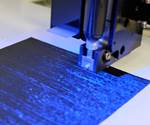Researchers develop nano-barrier for CFRP space applications
Developed by the University of Surrey and Airbus, the new nano-barrier material is intended to eliminate moisture absorption issues in spacecraft components.

Source | Airbus
Researchers from the (Surrey, U.K.) and (Ottobrunn, Germany) have developed a multi-layered nano-barrier that bonds with carbon fiber-reinforced polymers (CFRP), designed to eliminate the need for multiple bake-out stages in an effort to solve moisture absorption issues in space applications.
In their work , the researchers have shown that their nano-barrier — which measures only sub-micrometers in thickness, compared to the tens of micrometers of current space mission coatings, the researchers say — is less susceptible to stress and contamination at the surface, keeping its integrity even after multiple thermal cycles.
“We are confident that the reinforced composite we have reported is a significant improvement over similar methods and materials already on the market,” says Professor Ravi Silva, director of the Advanced Technology Institute at the University of Surrey. “These encouraging results suggest that our barrier could eliminate the considerable costs and dangers associated with using carbon fiber-reinforced polymers in space missions.”
“We have been using carbon fiber composites on our spacecraft and instrument structures for many years, but the newly developed nano-barrier together with our ultra-high-modulus CFRP manufacturing capability will enable us to create the next generation of non-outgassing CFRP materials with much more dimensional stability for optics and payload support. Reaching this milestone gives us the confidence to look at instrument-scale manufacturing to fully prove the technology,” says Christian Wilhelmi, head of mechanical subsystems and research and technology Friedrichshafen at Airbus Defence and Space.
Related Content
-
Arceon, Goodman Technologies to progress melt-infiltrated CMC
U.S. aerospace and defense markets are expected to benefit from Arceon’s expertise in C/C-Sic materials and Goodman’s presence in the nanocomposites ecosystem.
-
Wichita State researchers build composites strength, functionality with helical CNTs
Patent-pending chemically functionalizing helical carbon nanotubes (HCNTs) produce scalable nanocomposites that reduce weak interlaminar bonding, improve bonding, support repair and healing and more.
-
HydroGraph, NEI Corp. launch graphene dispersions line
Two novel dispersions, comprising HydroGraph’s pristine fractal graphene and NEI’s experience in battery materials, targets coatings, energy storage and composite materials.
.jpg;width=70;height=70;mode=crop)





